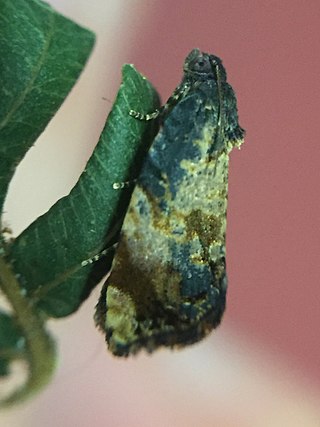
Philocryptica is a monotypic genus of moths belonging to the subfamily Tortricinae of the family Tortricidae. It contains only one species, Philocryptica polypodii, the leather-leaf star-miner, which is endemic to New Zealand. This species has been recorded in both the North Island and the South Island, as far south as Banks Peninsula. The preferred habitat of this species is native forest where the species' larval host is present. The larvae feed on Pyrrosia eleagnifolia, mining the host plant leaves. P. polypodii pupates within the final blotch-mine. Adults are on the wing in November and December.
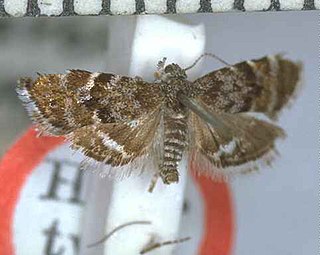
Asterivora marmarea is a species of moth in the family Choreutidae. It is endemic to New Zealand and lives in mountainous habitats. It has been observed in the lower parts of the North Island and the upper South Island. The larval host of this species is Celmisia gracilenta and adults of this species are on the wing in December and January.

Asterivora oleariae is a species of moth in the family Choreutidae. It is endemic to New Zealand and can be found on Stewart Island, Big South Cape Island and The Snares. There is one generation a year on The Snares with adults being on the wing in January and February. Larvae are feed on plants in the Olearia genus.

Batrachedra filicicola, also known as the ring fern spore-eater, is a species of moth of the family Batrachedridae. It is endemic to New Zealand and has been collected in the North Island. The larvae of this species feed on the spores of the silver fern. Adults are on the wing in November and December. This species is attracted to light and has also been collected in the day by sweeping silver fern fonds.

Physetica prionistis is a moth of the family Noctuidae. It was described by Edward Meyrick in 1887. It is endemic to New Zealand and is widespread throughout the North, South and Chatham Islands. This species can be found in open clearings of shrubland and forest at altitudes from sea level up to the alpine zone. Adults are on the wing throughout the year and are attracted to sugar traps and occasionally to light. The life history of this species is unknown as are the larval host species.

Hierodoris atychioides is a moth of the family Oecophoridae. It was described by Arthur Gardiner Butler in 1877. The female holotype specimen held at the Natural History Museum, London. This species is endemic to New Zealand, and can be found in the North, South and Stewart Islands. The larvae form webs of silk attached to frass and leaves on their hosts in which they shelter, often in the company of other larvae in their species. Their feeding habits have not been observed in detail but Hoare hypothesises the larvae may feed on dead or dying leaves. The larvae feed on a wide range of trees and shrubs, including Dacrydium cupressinum, Prumnopitys taxifolia, Dacrycarpus dacrydioides, Libocedrus bidwillii, Cupressus macrocarpa, Leptospermum scoparium, Kunzea ericoides, Ozothamnus leptophyllus, Abies, Picea, Pinus and Thuja species. Although they are regarded as a pest of exotic forests in New Zealand, the economic damage the larvae cause is minimal and they tend to be controlled only by their natural enemies. Larval enemies include the parasitic flies Trigonospila brevifacies and Pales funesta as well as parasitic wasps including Xanthopimpla rhopaloceros. The adult moths are day flying and are most common during the months of December and January. This species is variable in appearance as larvae, pupa and as adults, and it has been hypothesised that it is in the process of speciation.

Eudonia zophochlaena is a moth in the family Crambidae. It was described by Edward Meyrick in 1923. It is endemic to New Zealand. It has been hypothesised that this species is a North Island endemic. The adults of this species are on the wing from December until February. The larvae of this species are leaf miners of the leather-leaf fern Pyrrosia eleagnifolia.

Anisoplaca ptyoptera is a species of moth in the family Gelechiidae. It was described by Edward Meyrick in 1885 and is endemic to New Zealand. This species is found throughout the North and South Islands and prefers habitat where its host plants are common. The larval hosts of this moth are species in the genus Carmichaelia and the larvae stem mine the host plant. However larvae have also been observed feeding on gorse species and as a result their potential as a biological control for gorse has been researched. This behaviour has only been recorded in the Canterbury and Otago regions. A. ptyoptera overwinters as larvae and while in that life stage can be parasitised by species of wasp in the genera Zealachertus and Diadegma. Pupation begins in October. Adult moths are on the wing from October until May with peak emergence occurring in January. The adult moths come in two size classes and should the size of the female be in the larger class fecundity is improved. It is likely that this species has only one brood a year.
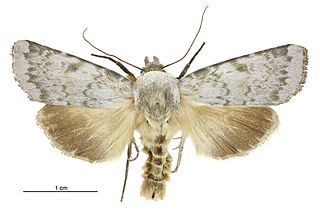
Physetica caerulea is a species of moth of the family Noctuidae. It is endemic to New Zealand and can be found from the centre of the North Island south, including the South and Stewart Islands. The adult moths are variable in appearance but can be distinguished by the bluish tinge to the forewings as well as the underside buff colour. However this species does have several forms including a very dark bluish black form, a brownish form and a green-brown form. It lives in open habitats and can be found in tussock grasslands and dunes and can normally be found from altitudes of sea level up to 900 m. Adults of this species are on the wing from August to April. As at 2017, the life history of is unknown as are the host species of its larvae. However it has been hypothesised that the larval host species is a tomentose plant.
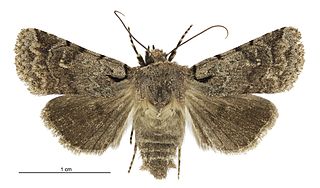
Austramathes fortis is a species of moth in the family Noctuidae. It is endemic to New Zealand and is found in both the North and the South Islands but has yet to be recorded at Stewart Island. It can be found in shrubland containing its host species at a range of altitudes from sea-level up to 1840 m. The larvae of this moth feed on several Melicytus species including M. crassifolius, M. alpinus, M. macrophyllus and M. novae-zelandiae. The larvae pupate in a cocoon of silk at the base of its host plant. It can take between 25 and 45 days before the adult moth emerges. Adults can be found on the wing during the months of July to March. The adults tend to be on the wing in twilight hours but have also been known to be active during the late afternoon. They are attracted to light but this behaviour may limit the number seen at light traps. The distinguishing feature of this moth is the curved black line at the base of its forewing. This species is unlikely to be confused with any other species in its range but it is very similar in appearance to A. squaliolus. However this latter species is only found on the Chatham Islands.

Ichneutica virescens is a moth of the family Noctuidae. It is endemic to New Zealand, and is found in the southern North Island and throughout the South Island. The species is found in alpine, sub-alpine, and down to sea-level in grassland habitats. Adults are on the wing from November through to April. The likely larval host may be grasses, but larvae have been reared on a range of plants. The adults are similar to I. panda, I. falsidica and I. nobilia, but is distinguished by size, wing colouration, and antennae formation.
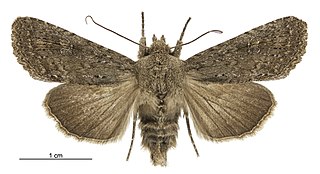
Physetica homoscia is a species of moth of the family Noctuidae. It is endemic to New Zealand and is found throughout New Zealand including in the Auckland Islands. This species inhabits places where its host plants are common and this includes costal dune habitat. It lives at a wide range of altitudes from sea-level up to at least 1750 m. The larvae of P. homoscia feed on Ozothamnus leptophyllus and Ozothamnus vauvilliersii. They are very active and drop to the ground when disturbed. Larvae are parasitised by a species of fly. This species pupates in the soil and the pupa life stage lasts for approximately 6 weeks. The adult moths are on the wing from September to June and are attracted to light. The adults of P. homoscia might possibly be confused with Ichneutica moderata however this latter species lacks the small white dots on the forewing veins of P. homoscia. Adults might also be confused with P. temperata but P. homoscia is significantly larger in size.
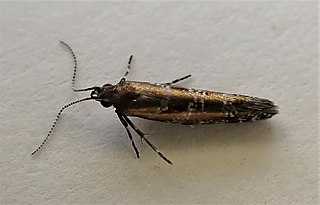
Chrysorthenches drosochalca is a species of moth in the family Plutellidae first described by Edward Meyrick in 1905. It is endemic to New Zealand and has been found in the North and South Islands. The larvae are leaf miners of Prumnopitys ferruginea. Adults are on the wing from January to March.
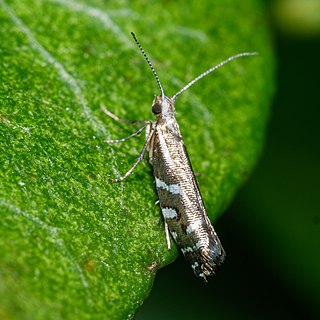
Chrysorthenches glypharcha is a species of moth in the family Plutellidae. It was first described by Edward Meyrick in 1919. It is endemic to New Zealand and is found in the North and South Islands. This species inhabits native forest with Podocarpus trees present. The larva and pupa of this species is currently unknown but the adults are on the wing in February, October and November. The adult moths are associated with Podocarpus totara and Podocarpus laetus.

Chrysorthenches halocarpi is a species of moth in the family Plutellidae. It was first described by John S. Dugdale in 1996. It is endemic to New Zealand and has been observed in the North and South Islands. The species inhabits native bush. Larvae have been collected in October and November. The larval hosts are Halocarpus bidwillii and H. biformis. Adults have been observed on the wing from November to February.

Chrysorthenches phyllocladi is a species of moth in the family Plutellidae. It was first described by John S. Dugdale in 1996. It is endemic to New Zealand and has been observed in both the North and South Islands. The larvae of this species feed on Phyllocladus alpinus. Adults have been observed on the wing in February, April and November.

Chrysorthenches polita is a species of moth in the family Plutellidae. It was first described by Alfred Philpott in 1918. It is endemic to New Zealand and it has been observed in both the North and South Islands. This species likely has two broods a year with one emerging in late spring and other in summer. The larvae mine leaves of Podocarpus species including Podocarpus totara. Adults have been observed on the wing in July to October and December to March.
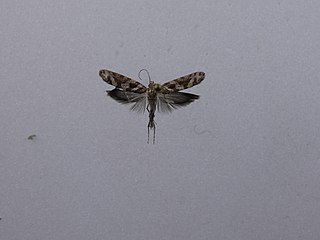
Chrysorthenches porphyritis is a species of moth of the family Plutellidae. It was first described by Edward Meyrick in 1885 and is endemic to New Zealand. This species can be found on both the North and South Islands in open native forest and scrub at altitudes from sea level up to 1370 m. The larvae feed on Podocarpus laetus, P. totara, P. nivalis, and Phyllocladus alpinus. The larvae create a shelter by loosely spinning together the leaves of its host plant and can be found feeding in groups. The pupa is formed inside a thin cocoon. Hudson was of the opinion that this species had two broods a year. Adult moths are on the wing all year round. The adults of this species, particularly the female, are variable in colouration and in forewing pattern.

Chrysorthenches virgata is a species of moth in the family Plutellidae. It was first described by Alfred Philpott in 1920. It is endemic to New Zealand and has been found in the North, South and Chatham Islands at altitudes ranging from sea-level up to approximately 1000 m. This species inhabits areas where its larval host plants, Libocedrus bidwillii and Cupressus macrocarpa are common. The larvae feed on the leaves of their hosts from under a silk shelter and pupate in a cocoon of thick silk covered in frass. Adult moths are on the wing from September to February as well as in April and June.

Chrysorthenches is a genus of moths of the family Plutellidae.






















